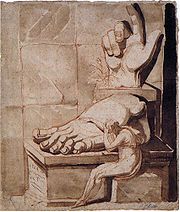
Ex pede Herculem
Encyclopedia

Heracles
Heracles ,born Alcaeus or Alcides , was a divine hero in Greek mythology, the son of Zeus and Alcmene, foster son of Amphitryon and great-grandson of Perseus...
", is a maxim of proportionality
Proportionality
Proportionality may refer to:*Proportionality , the relationship of two variables whose ratio is constant*Proportionality , A legal principle under municipal law in which the punishment of a certain crime should be in proportion to the severity of the crime itself, and under international law an...
inspired by an experiment attributed to Pythagoras
Pythagoras
Pythagoras of Samos was an Ionian Greek philosopher, mathematician, and founder of the religious movement called Pythagoreanism. Most of the information about Pythagoras was written down centuries after he lived, so very little reliable information is known about him...
. According to Aulus Gellius
Aulus Gellius
Aulus Gellius , was a Latin author and grammarian, who was probably born and certainly brought up in Rome. He was educated in Athens, after which he returned to Rome, where he held a judicial office...
' Noctes Atticae:
"The philosopher Pythagoras reasoned sagaciously and acutely in determining and measuring the hero's superiority in size and stature. For since it was generally agreed that Hercules paced off the racecourse of the stadium at Pisae, near the temple of Olympian Zeus, and made it six hundred feet long, and since other courses in the land of Greece, constructed later by other men, were indeed six hundred feet in length, but yet were somewhat shorter than that at Olympia, he readily concluded by a process of comparison that the measured length of Hercules' foot was greater than that of other men in the same proportion as the course at Olympia was longer than the other stadia. Then, having ascertained the size of Hercules' foot, he made a calculation of the bodily height suited to that measure, based upon the natural proportion of all parts of the body, and thus arrived at the logical conclusion that Hercules was as much taller than other men as the race course at Olympia exceeded the others that had been constructed with the same number of feet." (translated by John C. Rolfe of the University of Pennsylvania
for the Loeb Classical Library, 1927)
In other words, one can extrapolate the whole from the part. Ex ungue leonem, "from its claw [we can know] the lion," is a similar phrase, noted in William Rose Benet
William Rose Benét
William Rose Benét was an American poet, writer, and editor.He was the older brother of Stephen Vincent Benét....
's The Reader's Encyclopedia 1948.
The principle was raised to an axiom of biology
Biology
Biology is a natural science concerned with the study of life and living organisms, including their structure, function, growth, origin, evolution, distribution, and taxonomy. Biology is a vast subject containing many subdivisions, topics, and disciplines...
by D'Arcy Wentworth Thompson
D'Arcy Wentworth Thompson
Sir D'Arcy Wentworth Thompson CB FRS FRSE was a Scottish biologist, mathematician, and classics scholar. A pioneering mathematical biologist, he is mainly remembered as the author of the 1917 book On Growth and Form, written largely in Dundee in 1915...
, in On Growth and Form, 1917; it has found dependable use in paleontology
Paleontology
Paleontology "old, ancient", ὄν, ὀντ- "being, creature", and λόγος "speech, thought") is the study of prehistoric life. It includes the study of fossils to determine organisms' evolution and interactions with each other and their environments...
, where the measurements of a fossil jawbone or a single vertebra, offer a close approximation of the size of a long-extinct animal, in cases where comparable animals are already known. The studies of proportionality in biology are pursued in the fields of morphogenesis
Morphogenesis
Morphogenesis , is the biological process that causes an organism to develop its shape...
, biophysics
Biophysics
Biophysics is an interdisciplinary science that uses the methods of physical science to study biological systems. Studies included under the branches of biophysics span all levels of biological organization, from the molecular scale to whole organisms and ecosystems...
and biostatistics
Biostatistics
Biostatistics is the application of statistics to a wide range of topics in biology...
.
An actual foot of Heracles, though carved in marble, was purchased by the 4th Earl of Aberdeen
George Hamilton-Gordon, 4th Earl of Aberdeen
George Hamilton-Gordon, 4th Earl of Aberdeen KG, KT, FRS, PC , styled Lord Haddo from 1791 to 1801, was a Scottish politician, successively a Tory, Conservative and Peelite, who served as Prime Minister of the United Kingdom from 1852 until 1855.-Early life:Born in Edinburgh on 28 January 1784, he...
as a young man on the Grand Tour
Grand Tour
The Grand Tour was the traditional trip of Europe undertaken by mainly upper-class European young men of means. The custom flourished from about 1660 until the advent of large-scale rail transit in the 1840s, and was associated with a standard itinerary. It served as an educational rite of passage...
. Muriel Evelyn Chamberlain's biography (1983, p. 420) notes "Aberdeen did apparently secure one relic of the Parthenon, a foot of Hercules from one of the metope
Metope (architecture)
In classical architecture, a metope is a rectangular architectural element that fills the space between two triglyphs in a Doric frieze, which is a decorative band of alternating triglyphs and metopes above the architrave of a building of the Doric order...
s. It is mentioned among the goods he shipped home but has unfortunately disappeared."

